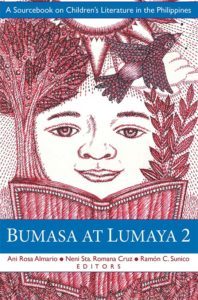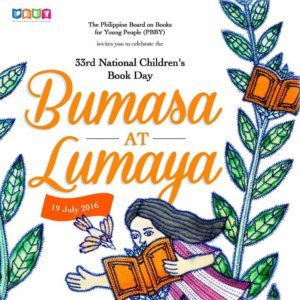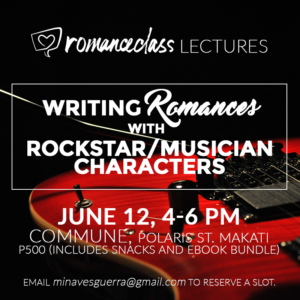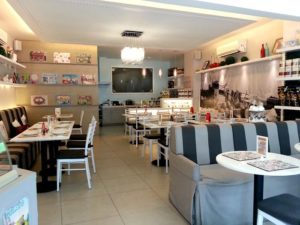Mina V. Esguerra's Blog, page 28
July 24, 2016
#FeelsRushIn, a #romanceclass event at Ayala Malls TriNoma
We’re always going to be ready to do a Feels Day, and we proved that when we put together #FeelsRushIn in 10 days. Ha!
I’ve blogged about #AprilFeelsDay and what a great day it was for authors and readers of romance (if I may say so myself). As soon as it was over we were thinking of when we could hold it again, and what it could have. And it turned out, we had another Feels Day sooner than anticipated.
Ayala Malls (via Filipino ReaderCon) tapped us to organize an activity that would bring attention to their Little Free Library project. These are, yup, little libraries set up in certain malls. You can leave a book, you can get a book, you can read it in the mall. Isn’t that perfect?
Our first event was held at TriNoma, on July 23.
A photo posted by Mina V. Esguerra (@minavesguerra) on Jul 22, 2016 at 10:11pm PDT
Chairs and a stage! It’s a big deal, haha.
A photo posted by Mina V. Esguerra (@minavesguerra) on Jul 23, 2016 at 8:01am PDT
Like the previous Feels Day, we sold #romanceclass books. Most of these books aren’t available in bookstores!
A photo posted by Mina V. Esguerra (@minavesguerra) on Jul 23, 2016 at 9:00am PDT
We also had more merch! Shirts and tote bags from WearDPT and vinyl stickers from Vinyliism.
The highlight of every Feels Day is the live readings. Herv Alvarez, Salve Villarosa, and new addition Migs Almendras read excerpts from books When Cocoy Became Kikay by C.P. Santi, Only A Kiss by Ines Bautista-Yao, The Bye-Bye Bouquet by Chi Yu Rodriguez, What About Today by Dawn Lanuza, and No Strings Attached (by me!).
(Full video of the reading from my book. I loved.)
July 19, 2016
Iris After the Incident

Chic Manila is my contemporary romance series set in the Philippines, with Filipino characters. Iris After the Incident is its 8th book (yay!), but they can all be read as standalones. Start with any book and then work your way back, not a problem.
Here’s Iris:

Description:
Which moment has defined your life so far?
Whether she likes it or not, Iris’s life has been divided into two: Before the Incident, and After the Incident. Something very private was made very public, and since then life has been about recovering from being shamed, discovering her true friends, and struggling to find a new normal.
Two years into this new life and she finally connects with a guy again. He lives in the apartment down the hall, he’s hot, and he doesn’t look at her that way. He doesn’t know what happened. But he also won’t give her his name, not right away—which has to mean he’s got something to hide too.
Iris wants to start over. Should she do that with the only person who will understand, or is this the same idiotic decision that got her in trouble in the first place?
Get it on: Amazon – Gumroad – iBooks – Smashwords
Order the Philippine print edition: bit.ly/mvebooks
July 18, 2016
Bumasa at Lumaya 2: Here to celebrate National Children’s Book Day [Blog tour]

Welcome to my stop on the Bumasa at Lumaya blog tour! We’re celebrating National Children’s Book Day on the blog. I’ve decided to devote this post to discussing Filipino YA, but you can check out the other posts as well at School Librarian in Action to see more from the tour.
Accompanying NCBD 2016 and the blog tour is the release of Bumasa at Lumaya 2: A Sourcebook on Children’s Literature in the Philippines. It’s exactly that, a book filled with what an educator or lit enthusiast needs to learn more about lit for children and young adults, as it’s being produced and enjoyed in this country.

So, I’m a YA reader, and that was how I approached this blog tour post and what I wanted to talk about in it. I first learned of the term YA when I was a teenager reading Sweet Dreams and Sweet Valley High (“Bantam YA” it said on the spines and front matter), and quickly attached myself to that category, realizing that there was a whole line of books being published exactly for me. But these were stories of young adults in America, and some things didn’t translate as smoothly — like high school students driving, like lockers in school, prom’s rituals, or even just being 18 and a high school senior. I was 16 when I graduated from high school, although that will change in life as well as in YA now that we’ve adopted K-12 in this country.
As an adult reader, I went back to YA by starting with the popular American books. Definitely read and enjoyed Rainbow Rowell (Eleanor and Park, Fangirl, Carry On), John Green (The Fault in Our Stars), Suzanne Collins (The Hunger Games trilogy), Jenny Han (To All the Boys I’ve Loved Before), E. Lockhart (We Were Liars), Emery Lord (Open Road Summer), Veronica Roth (Divergent trilogy), Marie Lu (The Young Elites), Kasie West (The Distance Between Us)…and more. Of these I fangirled Stephanie Perkins (Anna and the French Kiss, Lola and the Boy Next Door, Isla and the Happily Ever After) the most, showing up to her signings in Manila and Cebu — because I happened to be in Cebu on the same day for a wedding, it wasn’t me being too clingy I promise. I’ve been wanting to explore more YA outside of the US and have started with Australian books gifted by friends, and started with Melina Marchetta (Jellicoe Road).
As an author, I’ve dabbled in YA (my Interim Goddess of Love series) and led the #buqoYA workshop that focused on YA romance. Because I write romance.
But there’s more to YA than romance, more to YA than the US or the “western world,” and the essay “Filling the Gap: Young Adult Literature in the Philippines” in Bumasa at Lumaya discusses where we’re at in terms of this. I got the chance to ask authors Carla Pacis and Ramon Sunico some questions about YA in the Philippines.
Q: How much new YA per year should Philippine publishing aim to produce? In the ideal situation, how many titles should be we releasing, and what could that lineup look like? (ie what are the sub-genres? themes?)
Pacis: Themes would be those close to a teenagers heart like romance and fantasy but there should also be historical fiction, science fiction, horror and comedy. In short, everything.
Sunico: Right now, the YA horizon is wide open. When I began, the goal I set for myself was one to two titles a year.
After a few years though, I ran out of authors and was forced to turn to writers living outside the country to get any content at all.
So right now, sorry, but I think the “should” part of the question is more apt for a better developed industry like those of the US or Germany.
I can share though, that if one wants to do titles with decent production values and content that will be adopted by schools into their reading lists, one has to invest quite some time in the editorial process. One of my books began as a thesis and it took over a year before I was ready to publish it. I also had three other titles that took over a year before they were in publishable/marketable form.
Same answer for the sub-genre question.
While my personal preference is for either historical content or content that discusses contemporary issues of interest to the YA reader, I will pretty much look at anything engaging and well-written.
I must say though that the future seems to be in Filipino or street writing, a language category. The Mother Tongue project is also very exciting.
I think the great number of categories and formulaic definitions used in the States work well for their marketing and commercial culture where every submission can be slotted into a pigeonhole. That was not my experience in Germany or France though who both had broader and more flexible categories. My personal experience was with Beltz & Gelberg (Weinheim, off Heidelberg) and Ravensburger (Ravensburg).
Q: “The gap” being discussed seems to be YA that is taught in schools, because “in the wild” there’s a lot of young adult/teen fiction. Could a solution (if short-term) instead be a review of what students are reading outside of assigned texts, and determining ways to discuss them in class? Should we instead get educators to look at what’s out there (ebooks, indies), because there most likely is something out there discussing that theme or topic already? How could this work?
Sunico: It was Carla who thought up the title, but the original submission really wanted to underline how little YA publishing there was in the country. That’s the gap she was referring to. Yes, our focus is getting our books in the reading lists of schools.
I see what you’re saying about “in the Wild.” The old big story of course is Diary ng Pangit—started off as a personal project in Wattpad, was it and then saw success as a low production value title that sold 60, 000 copies.
Yes, although I wouldn’t call it a solution— I think a review is part and parcel of marketing.
From the school point of view, the reality is that the curriculum and syllabus are king. They’re not just looking for titles that the youth like reading; first they have to see how it fulfills the requirements of the schools.
In this regard, I’m quite interested in how the Janus Silang initiative of Adarna is faring. Here is an attempt to start off with what engages the youth after/outside school (DOTA) but written by an author with an academic background in lit-crit and po-mo.
As to getting educators to look at what’s out there: good luck.
My experience is that teachers resist new titles because these require more reading and new preparation. This is why most YA books being marketed by Cacho before for Anvil had to have review questions at the end of the books. Also, not a few of them are reactionary or backward looking—preferring Lola Basyang stories for no other reason than that they know this already. We’ve had some informal surveys where, at least for younger children in the provinces, their preferences for books were at odds with those of the teachers.
Pacis: I think what teachers of Literature are looking for are novels that are well-written and of substance or something that is worth discussing in class. It is probably a novel the students themselves would not choose for themselves because of their limited experience.
Q: We see at events, signings, and online interaction that the YA scene is driven by female readers, authors, bloggers. How does that affect workshops, calls for manuscripts, and other traditional publishing decisions?
Pacis: It would be great if there was another workshop for YA authors and the sectors you mention would most likely be chosen. They have the potential to be good writers and only need the encouragement and guidance.
Sunico: Yep. You know my one year at Anvil, when I was designated editor for YA, about 97% were written by females, many of them trained in your workshops.
Most of these 97% were about romance and young love—so I kept referring these to our romance editors. My superiors couldn’t get the distinction.
I think that this could be a symptom (I’m not sure) of the immaturity of our content production. (In Indonesia on the other hand, Rudy Gunawan, my friend in Gagasmedia, claied that most YA was written by men.) I’d like to consider myself gender blind but in this case, it’s impossible not to notice the preponderance of works by women.
I’ve never been to a workshop to learn how to write although I have given talks in a few. I don’t know how much gender thinking gets into the planning of the more established ones. Obviously, there can be workshops like yours that specifically target a gender.
Not sure, unless it’s a very specific project, how a publisher can take gender into account when making manuscript calls without raising the possibility of being accused of gender bias.
Q: What kind of Pinoy YA book do you wish were on the shelves right now? (List as many as you like — authors might take up the challenge to write just that haha!)
Pacis: All the genres are welcome. Pinoy writers aren’t writing for YA!
Sunico: I want a lot of well written, riveting books for YA.My real interest today is actually pre-reading books, chapter books and a lot of non-fiction. I think a lot of teenagers are already reading in all these online communitites anyway—and that’s the right place for fan fiction, not shelves, because that could cause a lot of IPR headaches.
As you can see by now, our titles landscape is very uneven, very patchy, like the head of someone with scalp disease. Loads of picture books that sound like Rene Villanueva or Russell Molina. Lots of very derivative fantasy, looking for an audience. Lots of romance and chick lit or whatever all these are called by Americans nowadays. Lots of Diary of a Wimpy Kid knock-offs. Am excited by the vigorousness of the graphic novel culture, but I wish they would think of their younger siblings once in a while—but hey, they’re teenagers.
Thank you, Ms. Carla and Mr. Ramon! I edited this a bit because I’d like to continue the discussion with Mr. Sunico and pick up on questions he asked me…but that can be for another post.

July 12, 2016
Giveaway: Thanks from me and #romanceclass!

I know it can be exhausting, trying to keep up with all the things that we’re doing. And if you have been trying to keep up, I want to thank you. And here’s a way I thought of doing that.
Prizes!
A note on this giveaway: These are the listed prizes. Winners will be able to choose 1 prize from this list. I will choose as many winners as I can afford. May Rafflecopter’s odds be in your favor!
And thank you for supporting all the things.
June 29, 2016
No Strings Attached (2016 new cover, print+ebook edition)


A short story about this book…
The dedication page for No Strings Attached, first published in 2010, contains this message:
Thank you, Chris.
Dedicated with much love to
B, H, L, D, T, M, M, J, and K.
(Wink wink.)
Written for a chick lit imprint at the time, No Strings Attached was my third book, and also my first experiment in stepping outside of myself and playing with tropes to form the characters and situations. I was Carla’s age, when I was thinking about this story, and so were most of my friends. We had a lot of conversations about where we thought we would be at thirty, and who we would be with. I was in a relationship at the time, but most of them weren’t. Then someone said, “You know what’s going to happen, right? We’re going to have to go younger.”
Now that I’ve seen what the thirties looks like–and it looks great what are you worried about–I guess I now feel that the book portrays a very specific freakout window of time. Carla the main character is 29 and turning 30 in a few months. All this drama will be over and quick. But when you’re going through it, you don’t know when it’ll stop bothering you. So that part I guess is fine as it is, but if I were the kind of writer then that I am now, I’d push for a bigger age gap.
We older, wiser readers can handle that, right?
No Strings Attached has been re-released with a new cover, designed by Tania Arpa, based on photography by Pach Urrea at instagram.com/romanceclasscovers.
Book description:
Carla’s 29 and a whiz at her job: she’s efficient, reliable, and a total genius when it comes to putting something together at the last minute. Her dating life is practically nonexistent though, and everyone has an opinion about that. Her girl best friend (who’s married) keeps trying to set her up with stable banker-types, while her guy best friend (single and proud of it) encourages her to play the field–no strings attached.
Then Carla meets hot, smug, sexy Dante, and he’s everything she didn’t know she liked. He’s also five years younger, and she thinks it makes him perfect for the non-relationship she had in mind. What happens to that plan when he thinks he’s met the one for him at 24?
Buy links: Amazon – Smashwords – Gumroad – PH print edition
June 13, 2016
#romanceclass lecture: “How to date a musician” (Writing rockstar romances)

We had our first #romanceclass lecture and it rocked! Sorry for the pun! But it did.
On June 12, Independence Day here in the Philippines, the #romanceclass community met again to have our regular book discussion — except we’ve now turned it into a “lecture” series for writers or aspiring authors. What’s the difference? Well, when we used to meet to discuss books, I think the general impression was that you had to read the assigned books first, when the truth was, we didn’t care. We just wanted to talk about romance, books, and ideas for writing.
So starting with the June discussion, on rockstars, we changed it up. The “lecture” was now open to anyone, whether you’d read any of our books or not, but with a lecture fee. That fee was for the lecture, the snacks, and a bundle of ebooks you can choose to read (for research and fun!) or not, but they’re yours. If you read the books after the lecture and want to squee about them, we’re around and on social media anyway!

This was our invite, where we did not reveal who the guests were. I mean, we did tell some people, but if you only saw the poster and were interested, you probably didn’t know who’d be speaking. And you would have been in for a surprise, because we had an awesome panel.
A photo posted by Mina V. Esguerra (@minavesguerra) on Jun 12, 2016 at 1:27am PDT
For our first “lecture” on writing romance featuring musicians, we had solo artist Zsaris Mendioro, Champ Lui Pio of Hale, and Celine Fabie of the Ryan Cayabyab Singers.
A photo posted by Mina V. Esguerra (@minavesguerra) on Jun 13, 2016 at 2:18am PDT
They’re fun! It takes a certain person to willingly talk to WRITERS about ROMANCE, and these three stepped up and were so insightful — and also respectful. No names were dropped or reputations smeared. But we still learned a lot about how they work as artists, how they factor in relationships with their careers, and what it’s like to be in a relationship with someone like them.
Zsaris has been working in the music industry for years but she’s just started her own career as a performer. Champ Lui Pio is, I should say, maybe a generation younger than my first rock star crushes, but those who had a thing for him? I get it, completely. You’re not wrong. He is exactly the Love Interest your book should have, and I will one-click that damn book right now. Celine is an award-winning author, my roommate at the UP National Writers Workshop, and we bonded over many, many meals. When I found out that she’s also a singer I quickly invited her to be part of this.
A photo posted by Mina V. Esguerra (@minavesguerra) on Jun 12, 2016 at 3:45am PDT
Planning something special for the lecture was a good call, by the way, because we had to make sure it was worth the trip for our audience! Some people who attended came from FAR AWAY places (I think as far as Pangasinan to the north!). Commune in Makati was a great venue, and having this on a Sunday meant no traffic and a lot of early attendees. Not a problem at all!
Everyone who attended got these ebooks free:
Playing Autumn (by me)
Songs of Our Breakup by Jay E. Tria
Just for the Record by Six de los Reyes
The Real Score by Kesh Tanglao
Scandalized by Tara Frejas
A Dream is a Wish by Edith Joaquin
A Captured Dream by Ines Bautista-Yao
You should definitely listen to Zsaris Mendioro’s music now! Here’s the Spotify link.
Champ Lui Pio and the band Hale took a break, and he thinks the time apart made them better now that they’re back together. He said it in sexier language that I won’t repeat, because too sexy. I bought their 2015 album, get it here too.
Celine Fabie performs with The Ryan Cayabyab Singers. Like the page on Facebook to find out when and where they’re performing next.
So far it seems like the idea of holding the lectures every two months is doable, and we’re already planning the next one. Stay tuned!
May 31, 2016
Recap: My time as a fellow at the 55th UP National Writers Workshop
A photo posted by Mina V. Esguerra (@minavesguerra) on May 25, 2016 at 10:56pm PDT
Surprise! This was one of those things I ended up doing. An opportunity to join the UP National Writers Workshop as a fellow came up, and I took it. The application required a work in progress, and I had two at the time of the deadline. One was an experimental not-dystopia, the other a contemporary romance that was going to be part of my Chic Manila series. My husband M wanted me to submit The Future Chosen, but I decided to apply “as myself.” The workshop has a reputation for being somewhat…harsh (“Whatever they tell you there, don’t cry!” was the advice of more than one person to me) but that didn’t scare me off. You probably know by now how much of a fan I am of experimenting on myself, for the sake of learning something new.
So I sent in an excerpt from Iris After the Incident, the contemporary romance I was writing at the time. This is the book description:
Which moment has defined your life so far?
Whether she likes it or not, Iris’s life has been divided into two: Before the Incident, and After the Incident. Something very private was made very public, and since then life has been about recovering from being shamed, discovering her true friends, and struggling to find a new normal.
Two years into this new life and she finally connects with a guy again. He lives in the apartment down the hall, he’s hot, and he doesn’t look at her that way. He doesn’t know what happened. But he also won’t give her his name, not right away—which has to mean he’s got something to hide too.
Iris wants to start over. Should she do that with the only person who will understand, or is this the same idiotic decision that got her in trouble in the first place?
While the book is as light and snarky as my other books, “The Incident” is a shadow that hovers over it. It’s a bit dark, in that way. Maybe exactly the thing I could send over to be workshopped? In any case, I was accepted. Yikes!

For the first time, the workshop was held in UPLB (it had been in Baguio before this year). We spent most of the workshop week at the BP International Hotel inside UPLB. My Instagram feed documented all of the meals, and I did that instead of commenting on the workshop itself because…I was nervous. I usually know my way around my little corner of publishing, but this was a new world, and I felt humbled and unsure. I decided early on that I was going there to learn, and to hear things meant for me, even if they probably weren’t what I usually heard, or wanted to hear.
That’s why there were more food shots than literature commentary.

What didn’t get included in the captions for the food pics: The many, many, many conversations I had with workshop fellows and panelists about romance, and Wattpad, and indie publishing, romance marketing, every little experiment I’ve tried that was fun so I kept doing it. I know I’m not the only chick lit/romance author to have gone through UPNWW, but it seems like I might have been one of the first to have a romance genre text workshopped. I did feel like I was representing the genre and this kind of writing, and that was both fun and a little daunting.
But primarily, fun. I need to emphasize that. I didn’t cry! Haha. I like talking about the prickly and sensitive themes and tropes. I enjoy talking about the genre and how to find readers and making attractive people read excerpts. It’s daunting only when I think of this being someone’s entry point into this thing I care about so much and I don’t want to screw up. I want to say the right things. I want to make sure I don’t misrepresent the community of authors and readers who love these books so much.

My session was during the second half of the workshop, later that week, and it was moderated by novelist Charlson Ong. Along with my application we all had to submit an essay answering the question of why we write what we write, and here’s what I sent them. And here’s a summary of the session from the UPNWW blog. I got asked some tough, but expected questions. I enjoyed answering every single one — not just the ones during the session, but every time someone asked me something. It felt good to have answers, or at least suggestions that come from experience. I had thoughts to share about engaging readers, and how certain works and authors could go a little further than maybe they originally intended. We who write “commercial” romance in English face the challenge of finding readers as well, but what we’ve done can work for others. In general I believe that good work will find an audience. Some may need more help than others, but there are many ways to help. I hope I was able to convey that if not in my own session then in the other conversations.

If as a romance author you feel that this was something that wasn’t open to you, I can tell you that it is. If you have any other questions about the experience, I can tell you more. All in all, a great experience. This was a fun group. I got to see great places, eat a lot of food, meet accomplished people. There was a performance night and I channeled Rachel Coates when I read some pages from one of my books — and got complimented for it. (“Thanks! I did a ‘Rachel.'”)
Summaries of all the sessions can be found at the UPNWW blog.
May 8, 2016
#romanceclass podcast: Nominate a book for us to feature
Get the full season 1 podcast in mp3 here.
Thank you for supporting the #romanceclass podcast! My co-producer Tania Arpa and I started this project because it seemed like a fun thing to do, you know, getting actors to read scenes from romance novels by Filipino authors.
It’s still fun, and we’re still totally into it, but now we’re seeing how important this is. In recording the episodes we learn a lot about language, sentence construction, effective character development, dialogue, tension. When the scenes are performed or played back for an audience, we learn about timing, and word usage, and clarity. Also, when everything works, people want to read and buy the full books. Or want to see and hear more scenes.
Also, it’s still fun to do.
As of right now, we’ve already recorded 16 new episodes that haven’t gone up on Youtube. We’re taking a break and doing post-production on those episodes, but we’re already getting questions about future seasons and books. We’re producing this almost completely out of our own pockets so if you want more seasons, I hope you consider buying the mp3 sets on Gumroad. You’ll get all the episodes as mp3s, as well as a guest pass so you can attend the next live reading free.
This week we added a new perk — buy the album and you can nominate a book that may be featured in a future season. The key word is “nominate” and we can’t guarantee that all books nominated will be accepted. But it’s there as a perk, if you want to use it. Details are in a PDF file that you can download once you purchase the season here: https://gumroad.com/l/SXHiW.
Thank you! Keep visiting romancepodcast.com for updates! We have more author interviews and yes, 16 new books to feature and soon!
April 18, 2016
#AprilFeelsDay: Thoughts and Feelings Recap
How do I even begin?

The #AprilFeelsDay tag on Instagram is my happy place right now. It’s a collection of photos taken during the event, and I was there, but I was running around and constantly thinking of what was to happen like ten minutes into the future, so I couldn’t exactly be in the moment.
We in the #romanceclass (romance in English by Filipino authors) community planned #AprilFeelsDay as a next step, after participating in several events as the “romance people.” We’ve done small-scale meetups and private gatherings, but haven’t yet organized an event that was open to the public and made everyone who attended “romance people” by default. Summer was as good a time as any to do it, so we chose April 17 as the day.
After considering various venues and cities, we decided on Pegi Waffles in San Juan. It’s a little out of the way but it’s a cute spot with great food, and on a normal day looks like this.

On April 17, it looked like this:
A photo posted by Miel Salva (@mielsalva) on Apr 17, 2016 at 3:01pm PDT
Still cute, but also packed! In the summer!
We sold books. Indie authors side by side with traditionally published romance authors.
A photo posted by Tara (@twostepflight) on Apr 17, 2016 at 1:19am PDT
We met and hung out with readers and authors…well, they did. I was running around and didn’t get to talk so much.
April 9, 2016
romanceclasscovers: Romance-y covers for our books
If you write romance with Filipino/Asian characters and prefer photo covers for your books, you know what a struggle it is finding the right cover for your book if you only looked at stock photo sites. There just aren’t enough cover-worthy romance stock photos with Filipinos (or Asians even), or at least not enough for all the stories we’ve been writing.
I’ve tried to find a solution for this by collaborating with Filipino style bloggers (and I have with several books!). Now we’ve taken a greater leap and launched something new: instagram.com/romanceclasscovers.
#romanceclasscovers is a catalogue of photos for sale, for use on fiction book covers (and their related marketing materials), hopefully providing us more options if we write books with Filipino/Asian characters. The first set featuring models Katrice Kierulf and Migs Almendras is up now. You’ll be able to purchase photos via Paypal and other payment methods, and the photos are priced depending on use. You can also ask to sponsor a shoot for more perks and to get the look you want.
Anyone can purchase photos from the project! Not just #romanceclass authors. I mean, if the photo fits, definitely go buy it!

I love how each photo comes with creative cropping and edit suggestions.
This is a collab project with photographer Pach Urrea. Also in the team is stylist Alex Lapa. Add romanceclasscovers to your Instagram so you get to see new photo sets as they come.







